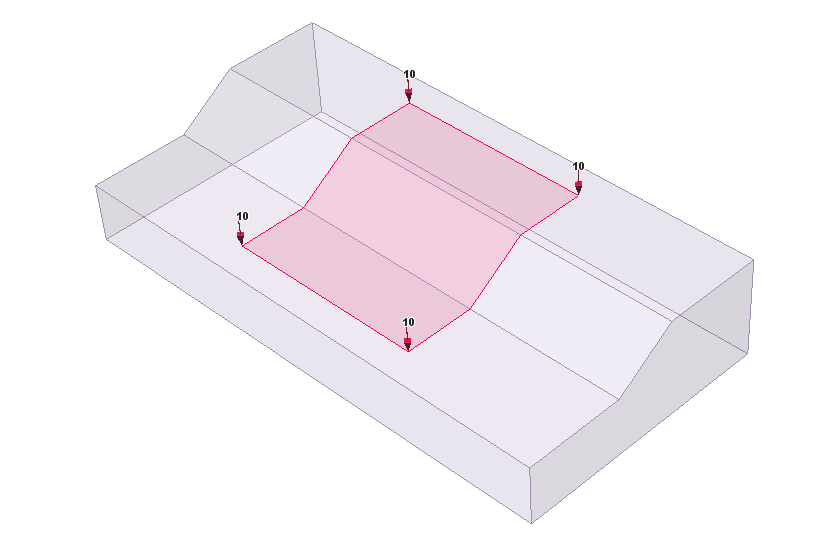Add Uniform Load
Uniform loads can be applied by:
- Defining projection shape (Add Load option)
- selecting faces, edges, or vertices of geometry (Add Load to Selected)
(faces, edges, or vertices) with the Add Load option and specifying Uniform Load as the Load Type.

To add a Uniform Load by projecting a region onto geometry:
- Select the Loading & Support
 workflow tab.
workflow tab. - Select Add Loads
 from the toolbar or the Loading menu.
from the toolbar or the Loading menu. - You will see the Add Load dialog. In this dialog:
- Select the Load Type = Uniform Load
- Enter the load Magnitude and specify the load Orientation (e.g. Normal, Local +x, Local +y, Local +z, Vector (x,y,z), or Trend/Plunge) specify shape and and dimension of the load region
- Specify location and orientation of the load region
- When finished specifying the load properties and preview of the applied load, select OK. The Uniform Load will be applied to faces, below load region.
- Check the direction of the arrows and the magnitude, to make sure that this is the load you wished to apply. If there is a mistake, you can select Undo and repeat the above steps to apply the correct load, or select and edit the load using the Properties pane to change the load parameters.
See below for details about the load magnitude and orientation.
To add a Uniform Load to a face:
- Select the Loading & Support
 workflow tab.
workflow tab. - Select Faces Selection
 as the Selection Mode.
as the Selection Mode. - Select the face(s) on which to apply the load.
- Select Add Loads to Selected
 from the toolbar or the Loading menu.
from the toolbar or the Loading menu. - You will see the Add Load dialog. In this dialog:
- Select the Load Type = Uniform Load
- Enter the load Magnitude and specify the load Orientation (e.g. Normal, Local +x, Local +y, Local +z, Vector (x,y,z), or Trend/Plunge)
- When finished specifying the load properties and the preview of the applied load, select OK. The Uniform Load will be applied to the selected face(s), as indicated by the display of red arrows and the magnitude.
- Check the direction of the arrows and the magnitude, to make sure that this is the load you wished to apply. If there is a mistake, you can select Undo and repeat the above steps to apply the correct load, or select and edit the load using the Properties pane to change the load parameters.
TIP: With the face(s) selected, you can also right-click on the viewing screen and select Add Loads from the Loading sub-menu.
See below for details about the load magnitude and orientation.
 or Vertices Selection
or Vertices Selection  to select the edge(s) or vertices, respectively, on which to apply the load.
to select the edge(s) or vertices, respectively, on which to apply the load.Load Magnitude
A distributed load magnitude is generally entered as a positive value. The direction of load application is specified by selecting an appropriate Orientation method (see below) in the Add Load dialog. If a negative load magnitude is entered, the direction of the applied load will be reversed.
Load Orientation
The load Orientation may be specified using one of the following options:
- Normal - loads are applied normal to the boundaries
- Local +x - loads are applied to the boundaries in the positive x-direction (i.e. +x)
- Local +y - loads are applied to the boundaries in the positive y-direction (i.e. +y)
- Local +z - loads are applied to the boundaries in the positive z-direction (i.e. +z)
- Vector (x,y,z) - specify a vector from the x, y, and z-directions
- Trend/Plunge - specify a trend and plunge (see Sign Convention for more information)
Flip Orientation
While adding a load, the orientation may sometimes be opposite from the intended direction (i.e. 180 degrees off). If this occurs you can select the Flip checkbox in the Add Load dialog to reverse the orientation of a load. After a load has been added, you can select the load in the Visibility pane and use the Properties pane Flip Orientation checkbox to reverse the load orientation.